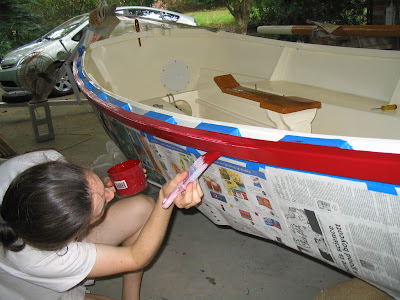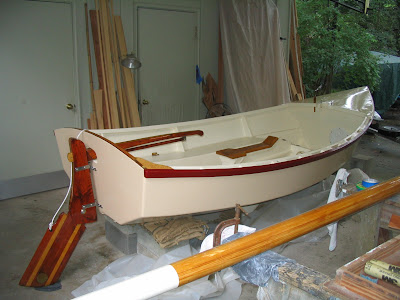We're still playing around with how to transport the mast most safely. It can go on top of my car on the roof rack, or on the boat like this (to a corner), or to the center of the transom. Traveling on the boat is a little scarier because it and the boat need lots of protection. For storage, this works really well, though, down the center of the boat to the transom it makes a nice A-frame for the tarp to sit over.
And the carport is finally clean and empty! Just in time for a hurricane that didn't come.
Downhaul on the boom. We played around with this, tried it aft of the parrel beads, but decided the forces worked out better with the downhaul fore of the parrel beads - of course we can change it again after we've gone sailing a few times and have a better feel of how it'll actually work.
Raised the sail a couple times to try things out, get situated, and loosen up the parrel beads and raising action. It was breezy and the boat was ready to sail.
Also lashed on the shackle for the mainsheet attachment to the boom.
We have an ingenious system for getting the boom and mainsheet out of the way when rowing - you just unclip the pulley with mainsheet from the bottom of the boat, clip it into a little line tied to the gunnel, then tie off the mainsheet so it isn't loose, and it holds the boom over to either side of the boat, clear of the oars and your head.
Here's a close-up of the system on the gunnel.
And another view of the mainsheet and boom out of the way on the gunnel.
Lowering the sail.
And all protected for the storm that didn't come our way. Daddy also glued on the leather strips on the transom for the oars to rest on when not in use, and after that was done, the boat was officially finished and ready to sail. There are going to be some adjustments, and actually I think we're going to have to re-do the foredeck porthole because we can't open it - the plastic warped some when I screwed it on because the holes didn't line up exactly - but that's can wait till we've launched.
Planning on sailing September 9, probably at Dickerson Bay in Panacea. I'll post when we know for sure so that anyone can come see the boat if they want.
































